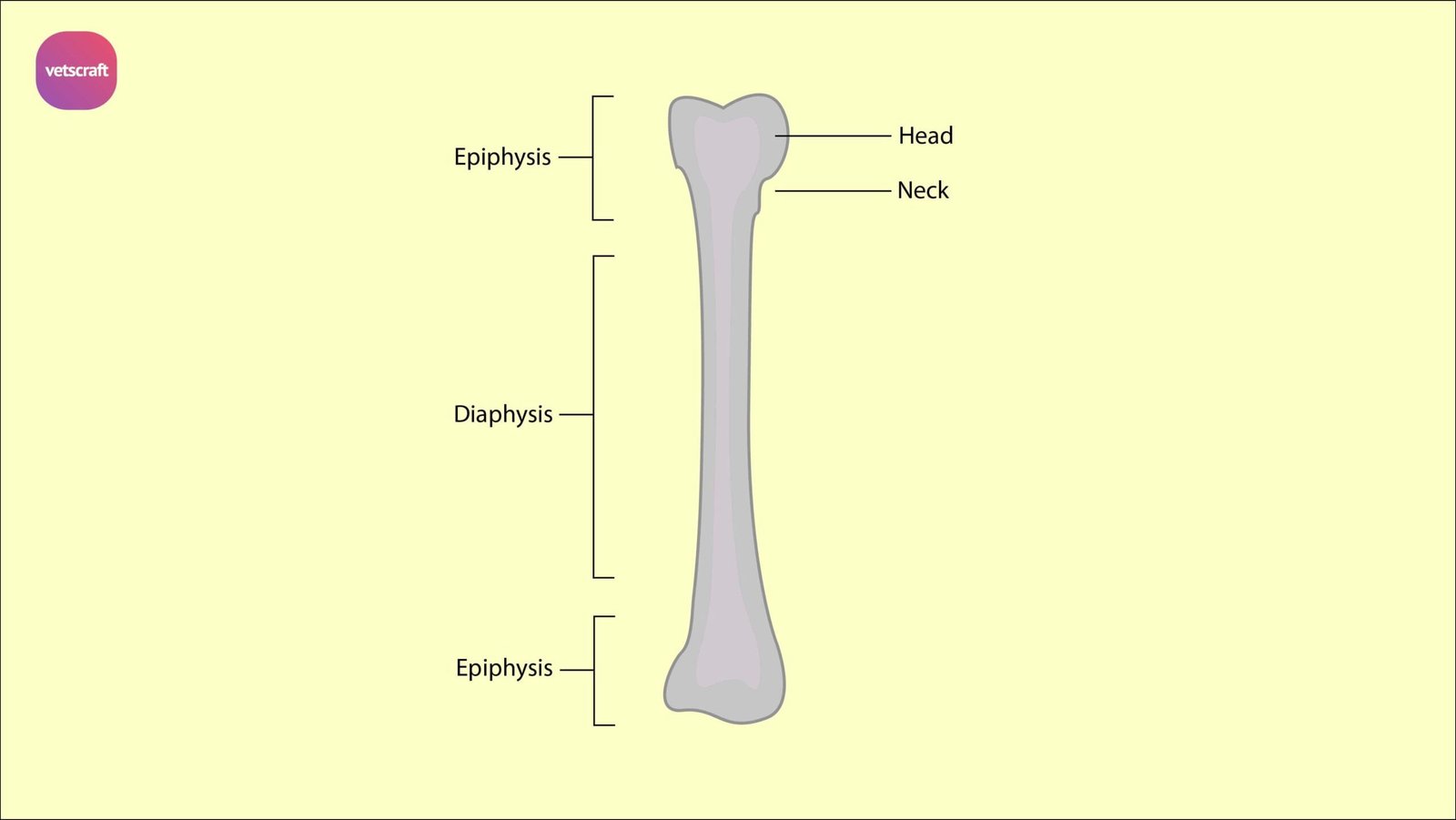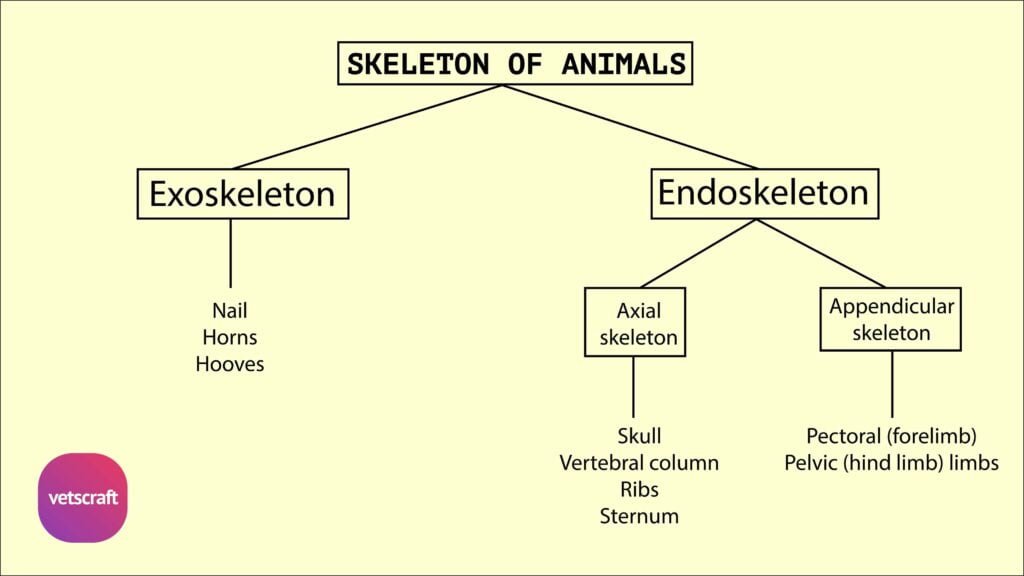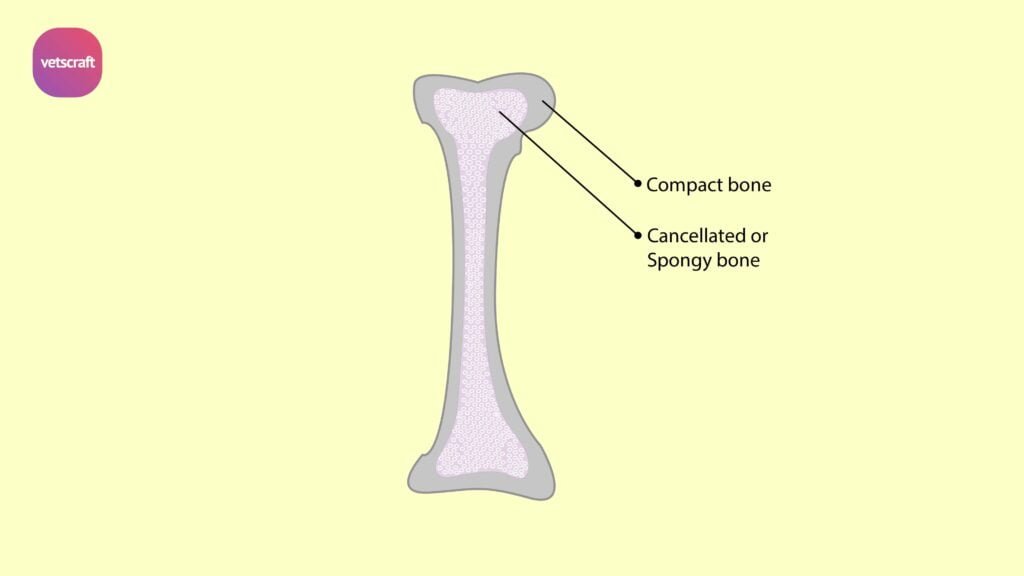TABLE OF CONTENTS
Veterinary Osteology Terminology: Bone Features & Long Bone Parts
Terminology in osteology refers to the specific anatomical terms used to describe the various features, landmarks, and structures of bones. These terms help in identifying and communicating the shape, position, and function of different parts of a bone, such as projections (e.g., spine, tubercle), depressions (e.g., fossa, groove), openings (e.g., foramen, canal), and joints (e.g., condyle, head).
In veterinary anatomy, understanding these terms is essential for studying the skeletal system, diagnosing bone-related conditions, and performing surgical procedures accurately.
Terminology in Osteology
The surface of bones presents a number of features in the form of prominences, depressions, perforations, etc. These may be articular (forming joints with corresponding articular areas of another bone) or non-articular, providing attachment to muscles, tendons, and ligaments.
| Bone Feature | Definition |
|---|---|
| Process | A general term for a prominence. |
| Tubercle | A small blunt projection. If more developed, it is called a tuberosity, while a trochanter is the largest of these. |
| Spine | A pointed projection. |
| Crest | A sharp ridge. |
| Head | A rounded articular enlargement at the end of a bone; it may be joined to the shaft by a neck. |
| Condyle | A somewhat cylindrical articular eminence, while an epicondyle is the non-articular projection associated with it. |
| Protuberance, prominence, eminence, torus | Various types of bony projections. |
| Trochlea | A pulley-like articular area. |
| Glenoid cavity | A shallow, cup-like articular depression. |
| Cotyloid cavity | A deep, cup-like articular depression. |
| Line | A faint elongated elevation, whereas a crest is a more prominent elongated elevation. |
| Facet | A flat articular surface. |
| Foramen | A perforation for the transmission of vessels, nerves, etc. |
| Sinus | An air cavity within the bone, lined by mucous membrane, that communicates with the exterior. |
| Hiatus | A depression leading to two or more foramina. The terms fossa, fovea, and sulcus denote various forms of depressions. |
| Cleft | A fissure in a bone. |
| Lamina | A thin plate of bone. |
| Cornu or hamulus | A curved, horn-like process. |
| Canal | A bony tunnel (a foramen of some length). |
| Meatus | A narrow passage. |
| Articular process | A projection that contacts an adjacent bone. |
| Articulation | The region where adjacent bones contact each other — a joint. |
| Canal | A long, tunnel-like foramen, usually a passage for notable nerves or blood vessels. |
| Eminence | A relatively small projection or bump. |
| Suture | Articulation between cranial bones. |
| Labyrinth | A cavity within a bone. |
| Malleolus | One of two specific protuberances of bones in the ankle. |
| Ramus | An arm-like branch off the body of a bone. |
| Angle | The corner of a bone found between two borders. |
| Articulation | A joint or union between two bones. |
| Body (corpus) | The largest or principal part of a bone. |
| Border | The edge of a bone, usually referring to a flat bone. |
| Condyloid cavity/Acetabulum | A deeper articular depression. |
| Epicondyle | A non-articular projection adjacent to a condyle. |
| Fissure | A narrow cleft in a bone. |
| Fontanel | An unossified region between skull bones. |
| Fossa | A concavity or depression; literally a ditch. |
| Fovea | An articular surface in the form of a very small pit or depression. |
| Groove | An elongated concavity between parallel ridges. |
| Incisura | A notch-like depression. |
| Linea | A narrow ridge or line — a very small linear elevation. |
| Manubrium | A flat, handle-like projection. |
| Notch | A deep or large indentation, usually for articulation. |
| Plexuses | A network or tangle of nerves. |
| Ridge | A narrow, rounded elevation on the surface. |
| Squama | The flat portion of a cranial bone. |
| Styloid | Literally a pencil-shaped, pointed process. |
| Symphysis | A union in which two similar bones are firmly connected by cartilage. |
| Trochanter | A very large, non-articular prominence. |
| Tuberosity | A large, rounded, uneven projection. |
Terminology in Osteology for Long Bones

| Long Bone Feature | Definition |
|---|---|
| Diaphysis | The long, relatively straight main body of a long bone; the region of primary ossification. Also known as the shaft. |
| Epiphysis | The end region of a long bone; the site of secondary ossification. |
| Epiphyseal plate | Also known as the growth plate or physis. It is a thin disc of hyaline cartilage located transversely between the epiphysis and metaphysis. In humans, the epiphyseal plate typically disappears by twenty years of age. |
| Head | The proximal articular end of the bone. |
| Metaphysis | The region of a long bone situated between the epiphysis and diaphysis. |
| Neck | The region of the bone between the head and the shaft. |

